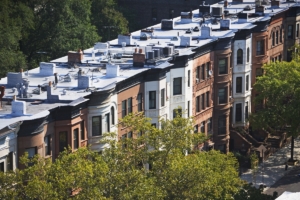
The condo building One57 embodies Midtown glitziness, but at least 10 units in it have sold at a loss over the last five years — five of them at losses in excess of $5 million each.
A wave of economic growth in New York City in the wake of the Great Recession has helped push home prices to record highs in the past five years. But even in a city with a booming economy and global appeal, it can be easy to lose money on real estate, particularly for those looking to make a quick buck.
Returns on homes have broadly underperformed other asset classes, such as stocks. And a significant chunk of New Yorkers who bought and sold apartments over the last five years have lost money outright. Of the more than 16,000 apartments that StreetEasy was able to identify as bought and resold from 2014 through 2018, 7.7 percent were sold at an outright loss. These losses came despite prices rising citywide during the same five-year period by 17 percent, according to the StreetEasy Price Index.
Owners selling at a loss faced a median markdown of 9.9 percent from their original purchase price. However, that number — along with the total number of homes sold at a loss — includes only the difference between the final purchase and sale price. Adding in the costs of agents, lawyers, taxes, and renovations underscores just how difficult it can be to make money in the New York City real estate market, particularly for those who plan to sell their home after a short period of time.
A total of 1,295 homes were bought and subsequently sold at a loss between 2014 and 2018. Many were concentrated in certain pockets of New York, but these pockets were located across the city, and across various price points and home types.
Struggles in Midtown
Pricey condos in Midtown were among the largest groups of homes sold at a loss during this period. Among the 66 condos bought and resold, 26, or 39 percent, sold for a loss. The area was also among the most expensive in the city, with a median price of $2.5 million for condos bought and resold in the period, and a median markdown of $660,000 for those that sold at a loss.
Though the Midtown condo losses were spread across 11 different buildings, 10 units that sold at a loss were in One57, the luxury tower that has become an exemplar of New York’s glitzy building boom. The foreclosure of the 79th floor unit received the most attention for its $14 million price cut at auction — the largest of any loss in our analysis. But another five units sold for losses of more than $5 million each, including this 77th floor unit, which sold for $5.8 million below its original purchase price of $47.8 million.
All told, units in One57 accounted for 9 of the 20 units that sold at a loss of more than $1.5 million, with listings in other prominent Manhattan condo buildings, including this 44th floor unit in 20 W. 43rd St. and this penthouse in 15 Central Park West helping round out the list. Seventeen of the top 20 losses were condos.
Price Cuts on Co-ops
While it may come as little surprise that condos in pricey new developments have trouble maintaining their value, co-ops were not immune from losses. Sellers took losses on 194 co-op units resold between 2014 and 2018, including 48 on the Upper East Side and 23 on the Upper West Side. The median price of co-ops that sold at a loss in both areas was $1.5 million — more than the average for a home in Manhattan. Co-ops that sold at a loss faced a median haircut of $80,000, and include homes such as this 2-bedroom in Lenox Hill, which sold for $1.4 million in May 2017, and resold just over a year later for $175,000 less.
Price Matters, But Only to a Point
Manhattan had a greater share of homes sell at a loss than any other borough, at 13 percent. But the median initial price of homes resold at a loss was just $575,000, only slightly higher than the $505,000 median sales price for the city over this five-year period. Significant shares of homes resold at a loss in neighborhoods as varied as Williamsburg (11 percent), Midland Beach, Staten Island (35 percent), Pelham Bay, Bronx (18 percent), and Glen Oaks, Queens (15 percent).
Losses on Homes Much Higher in Reality
Measuring only the gross difference between the purchase and sale price in official tax records means these numbers are an extraordinarily conservative indicator of the total net losses homeowners faced. Many more owners were likely to find themselves underwater when accounting for the costs of agents, taxes, and remodeling.
The median return for all homes bought and sold during the period was a cumulative 43 percent, or a median of 22 percent per year, but that too does not account for any additional costs. This 2-bedroom in Battery Park City was purchased for $708,000 in October 2015, and resold for $1,067,500 in January 2017 — a cumulative return of 51 percent. However the photos in the listing clearly show a substantial investment in upgrades between the purchase and sale dates. Adding these additional factors can make the math much more daunting for those hoping to make a windfall from the sale of their home.
How We Did It
We identified repeat sales by matching address data from public sale records from the New York City Department of Finance for transactions between Jan. 1, 2014, and Dec. 31, 2018. Units that sold for less than $100,000 and sales that were less than 180 days apart were not considered in the analysis.
—
Hey, why not like StreetEasy on Facebook and follow @streeteasy on Instagram?









